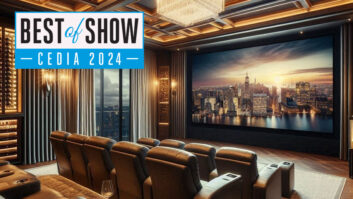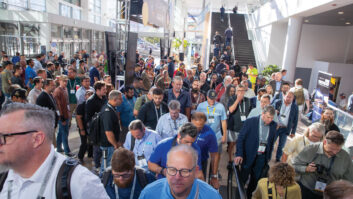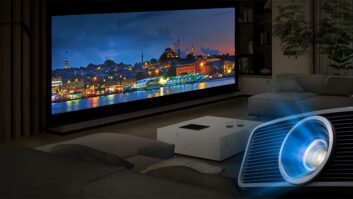
This sign on the side of the Las Vegas Convention Center shows the NAB’s direction: Their convention is about more than broadcastingAlthough the name National Association of Broadcasters conjures images of a trade show with broadcast equipment, such as transmitters and large camera systems, it is much more than that. In recent years the NAB has been about content and how it is created and distributed by any channel or in any form. The NAB itself has recognized the place of non-traditional media and production houses for years, and one only needed to take a look at their logo signage around the NAB Show in Las Vegas last month to see the lack of focus on “broadcasting.”
NAB’s concentration on content aligns much more than one would think when remembering that content is at the center of what we help clients access, manage, control, store, transfer, and finally display or play back. That intersection has many clues for where our industry is going in an interconnected and inter-related world of content where a single distribution channel no longer dominates.
Perhaps the biggest task coming out of NAB is to count all of that up, giving us this month’s theme of “video by the numbers.”
Focus on 4K Content
The first number is 4, as in 4K–the high-resolution video format that was most frequently referred to at NAB despite efforts to re-brand it as “UHD.” Displays for 4K/UHD are available and were shown all over CES in January, but the worry was that without content the format will have a hard time gaining marketplace traction. A walk around the NAB showed those concerns unwarranted with all the gear needed for 4K from cameras to editing systems to storage systems and yes, to distribution on the show floor. If the availability of equipment is on your “will 4K make it?” checklist, then you can mark that one off.
Indeed, moving a few years down the road, it isn’t all that far out of the question to see more and more programming shot in 4K regardless of the resolution used when it is distributed. This “shoot one/distribute many” way of looking at things lets producers have the maximum quality for future 4K channels or theatrical distribution, conventional HD or the various resolutions used for streaming services. Put another way, shooting in 4K means never having to say you are sorry.
Moving 4K programming out to consumers involves another set of numbers, as well: 265. Actually, it is H.265 or more formally, “High Efficiency Video Coding” (HEVC). What makes H.265 more than “0.001” better than the current H.264/AVC is really the number 50-percent. Or, to be exact, the fact that content encoded in HEVC can be transmitted at about half the bit rate of H.254. We grant you that 20Mb/s is still a fat pipe, but it is certainly manageable. HEVC encoders were on display from a number of vendors at NAB and real-time HEVC encoding will be available by mid-year.
That said, the consensus is that it will be about a year before samples of consumer-product ready HEVC decoder chips will be available and perhaps another nine to twelve months after that before production chips baked into displays, set top boxes and the like. Those numbers, as much as anything else, will guide the ability of 4K program transmission to be available on a wide scale basis.
What About HDMI 2.0
So far it looks as though NAB had the makings of all the numbers needed to let 4K/UHD become a reality, but we still have to get the content from the set-top or player to the display. That requires one number talked about, but not seen at NAB: The next version of the HDMI standard some are calling “HDMI 2.0,” but since it is not yet announced, that name is subject to change.

NHK demonstrated not only 8K, but 120Hz capture and display during NAB. The high frame rate delivered incredibly smooth motion.Here, more numbers: the current HDMI standard accommodates 4K/30p/8-bit color at about 300MHz and 9.0Gbps data. To move things up to the 4K/60p images with 10-bit or 12- bit color floated at NAB will require at least twice that: 600MHz and data at 18Gbps. Add in to this numerical equation the fact that despite lots of behind the scenes talk at NAB that it is “just around the corner,” the plain fact is that we’re still waiting for “HDMI 2.0” to become official.
These specs mean that new silicon is needed, and the new chips will require a development cycle similar to that just described for the new HEVC decoder chips. In a perfect world this means one product cycle before we see it in things you buy, but it could be two or maybe even three depending on how everything lines up. Total these numbers up to the bottom line and the message is that you probably won’t see products with the new HDMI standard for a while so you are reasonably safe with the current standard for now.

Sony used B+NAB as a platform to introduce two 4K/UHD displays along with their new professional gear.HDMI moves content from a source to the display but one of the big unanswered questions about 4K/UHD is how will that content get into the home? At NAB some additional layers of that onion were peeled back. Some answers came at NAB from Sony with pricing announced for a pair of UHD displays: a 55-inch set at $4,995 and a 65- inch model at $6,999. For content, Sony has been making a dedicated 4K content server box available at no cost to those shelling out $25,000 for their 84- inch UHD set but that unit is specific to that model. For those buying the new, smaller, models a newer content server will be available for $699 but it is said to be Sony-specific and unlikely to be compatible with other UHD displays you supply to clients.
An alternative shown at NAB was the RedRay player from the same Red Digital Cinema folks who are a leading supplier of 4K and 4K/High Frame Rate (HFR) cameras. As is the case with Sony’s unit the RedRay is a “forward and store” product. Thus, the content available through their partnership with ODEMAX has to be selected in advance for download to an internal drive for later viewing. No major studio deals yet, but they are said to be in negotiation.
All of this shows that the numbers are falling into place for 4K/UHD. Does this mean it is for real or will it be, as some were suggesting, “just another 3D?” The probable answer is that, unlike 3D, as time moves forward more and more high-value content will be shot in TV as facilities update their equipment over time. The displays will be there, and applications outside of consumers’ homes will make them a staple in the commercial, industrial, medical, and command/control worlds. With UHD display prices already dropping to under $1,500 for a 55-inch set as we write this, displays will migrate to 4K over time as well. Content, content, content. That’s what it is all about.
But what about that popular number from the last few NAB shows: three, as in 3D. To be sure the enthusiasm has died down and there was not as much 3D gear in evidence as in previous years. A good gauge of where 3D stands is the fact that Cameron|Pace Group, a leading supplier of mobile production facilities for 3D, was very much in evidence at NAB last year. This year they were not to be found on the show floor and their mobile units were not parked in the area between the Central and South Halls. Where they were visible was in the announcement that Cameron|Pace will integrate Dolby Lab’s glasses-free Dolby 3D in its production workflow and that they will collaborate on its use. This sort of endorsement from a leading proponent of 3D for an auto-stereoscopic format is important, but the key will be to see if any of the display brands, many of whom have their own “glasses-free” systems, will adopt it.
The Second Screen
As to 3D in general, the Dolby format, which did look impressive in demos, points to another number in the NAB universe: Two, as in “second screen.” Additional content related to a broadcast program but separately distributed to phones or tablets was a key topic at NAB that has relevance for the custom market on a few levels. First is the relationship between 3D and “second screen.” Second screen applications require viewers to take their eyes off the main (first) screen to look at a the second screen to view, chat, tweet, or comment on the extra data. With “second” on both screens, a bit of refocusing of the viewers’ eyes is needed, but that’s it. However, when the main screen is 3D and the second screen is not there is the added complication of removing glasses as well as adjusting to different screen brightness. This led some to comment that “second screen is killing 3D, resulting in a renewed push in some quarters for glasses-free TV such as Dolby 3D, to make things easier on the viewers’ eyes.

Digital cinema camera company Red is working with ODEMAX to create a program delivery service for its 4K RedRay player.A more pressing reason to note the growth of the second screen is the load it places on home network bandwidth. It is not difficult to picture some family members streaming a movie or program with each of them is also engaged in a separate second screen application or checking their Facebook page while elsewhere in the house someone is doing research for a homework or involved in a late-night web conference. Add in the web-based security cameras and other network connected devices or sensors, and you can easily see buckets of bits being consumed.
How to avoid this? Let the second screen be a good model to remind your clients that they might need a second (or third!) network at the least and enterprise grade network infrastructure that is robust, secure and remotely managed.
Before resetting our NAB numbers to zero there are just a few more to make note of. NAB is often the host to technology demonstrations from international broadcasting and research organizations, and this year’s event was no exception.
Count these numbers up from the display by Japan’s NHK: 8K video in a theater with 22.2 sound on a 300-inch screen. The 7680 x 4320 video from the London Olympics and Rio’s Carnival was so crisp and realistic that it seemed three-dimensional when combined with the three layers of sound. Adding more numbers to the 8K display was the use of two standard broadcast channels to prove that 8K content could be sent over the air, albeit via a system that is not likely to gain approval for the U.S.
More “8K numbers?” NHK also showed 8K video at a 120Hz frame rate. The improvement in image quality over 8K at a mere 60Hz was clear even though the image was down converted to 4K to show on a standard flat-panel display.
A final set of numbers describes a unique soundbar design from Korea’s ETRI research organization. Their SoundWindow uses reflected sound and custom DSP to present the 22.2 sound from an 8K presentation with a total of 32 compact drivers; 16 each above and below the display. The goal of delivering a “sweet area” rather than a single “sweet spot” was achieved and given the association of this project with one of the major Korean manufacturers you might see this project in a commercial version within the next year or so.
When we look at numbers, someone will inevitably ask what they add up to at the bottom line. Summing up this year’s NAB the clear message is that broadcast and professional technology is ready for 4K. While it may ramp up slowly as the final pieces of the distribution puzzle fall into place let no one think it isn’t going to become a major force in our world sooner than later. As regards 3D, we’ll paraphrase one of our favorite quotes from Monty Python: “This format isn’t dead, it’s only sleeping.” The numbers at NAB add up to it waking up and coming back for event and movie programming in the long term.
At the high and low end of our number scale, all are advised to keep an eye on second screen as it increases in popularity and on 8K as it is part of the future of broadcasting. No matter how you look at the numbers, NAB 2013 was a show with important business clues for the custom industry.
Based in Los Angeles, Michael Heiss ([email protected]) is a CEDIA Fellow and contributing editor to Residential Systems.






